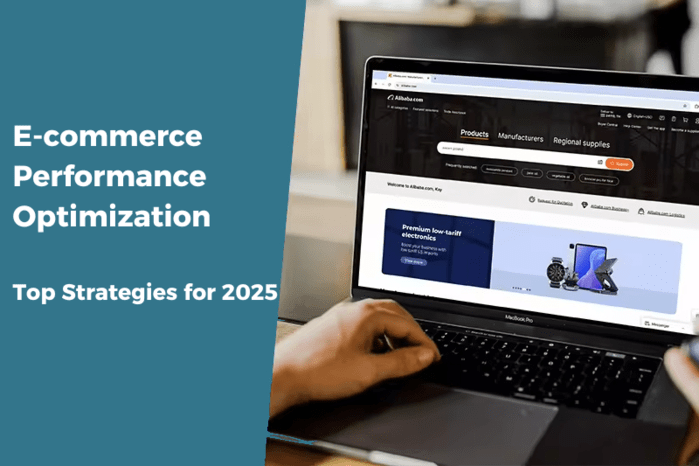What’s holding your e-commerce store back from reaching its full potential? If you’re experiencing slow load times, abandoned carts, or low conversion rates, you’re not alone. According to recent studies, even a one-second delay in page load time can reduce conversions by 7%. That’s a massive revenue loss.
Optimizing your e-commerce store for performance in 2025 isn’t just about speed, it’s about creating an experience that keeps customers engaged, drives conversions, and maximizes efficiency. In this guide, I’ll walk you through the best strategies for e-commerce performance in 2025, covering everything from site speed to AI-driven personalization.
1. Enhance Website Speed and Performance
Speed is non-negotiable. Customers expect pages to load in under three seconds, and Google prioritizes fast-loading sites in search rankings. To optimize performance:
- Use a Content Delivery Network (CDN): CDNs distribute your content across multiple servers worldwide, reducing latency and improving load times.
- Optimize Images and Media: Compress images using modern formats like WebP and leverage lazy loading to improve initial load times.
- Minimize HTTP Requests: Reduce unnecessary scripts, plugins, and third-party integrations that slow down your site.
- Enable Caching: Browser and server-side caching ensure returning visitors experience faster load times.
2. Mobile Optimization Is a Priority

Over 70% of e-commerce traffic now comes from mobile devices, meaning your website needs to be fully optimized for mobile experiences.
- Implement Responsive Design: Your site should adapt seamlessly to any screen size.
- Optimize Checkout for Mobile Users: Reduce form fields, use autofill options, and integrate digital wallets like Apple Pay and Google Pay.
- Accelerated Mobile Pages (AMP): Using AMP can significantly improve mobile page speed, leading to higher engagement and conversions.
3. AI-Driven Personalization for Higher Conversions
Personalization is no longer a luxury—it’s an expectation. AI-powered tools can analyze customer behavior and deliver tailored experiences that drive sales.
- Dynamic Product Recommendations: Use AI to showcase products based on past purchases, browsing history, and real-time behavior.
- Chatbots and Virtual Assistants: AI-driven chatbots can provide instant support, answer FAQs, and guide customers through the buying process.
- Personalized Email Campaigns: Leverage AI to send automated emails based on user actions, such as abandoned cart reminders and personalized product recommendations.
4. Streamlining Checkout for Reduced Cart Abandonment
Cart abandonment is one of the biggest challenges in e-commerce. A complicated checkout process can drive customers away before they complete their purchase.
- Offer Guest Checkout: Forcing users to create an account leads to frustration and lost sales.
- Minimize Form Fields: The fewer fields a customer has to fill out, the better.
- Multiple Payment Options: Accept various payment methods, including credit cards, PayPal, digital wallets, and Buy Now, Pay Later (BNPL) services.
- Transparent Pricing: Unexpected fees at checkout lead to higher abandonment rates. Display taxes and shipping costs upfront.
5. Leveraging Headless Commerce for Scalability
Traditional e-commerce platforms can be limiting, especially when you want to scale. Headless commerce decouples the front-end and back-end, allowing for more flexibility and faster innovation.
- Faster Load Times: Headless architecture reduces load times by serving content more efficiently.
- Omnichannel Selling: Seamlessly integrate your store across websites, mobile apps, social media, and marketplaces.
- Customization: Developers can build unique, highly customized shopping experiences without backend limitations.
6. SEO and Content Optimization for Organic Growth

SEO is the foundation of long-term e-commerce success. Without it, your store won’t attract organic traffic.
- Keyword Optimization: Use relevant keywords naturally in product descriptions, blog content, and metadata.
- Technical SEO: Improve site architecture, use structured data, and fix broken links to enhance search rankings.
- High-Quality Content: Regularly publish valuable content like buying guides, product comparisons, and industry insights to establish authority.
- Voice Search Optimization: With more users relying on voice assistants, optimize content for conversational queries.
7. Data-Driven Decision Making
You can’t improve what you don’t measure. Tracking key performance indicators (KPIs) and making data-driven decisions will help you continuously optimize your store.
- Analyze User Behavior: Use heatmaps, session recordings, and analytics tools to understand how users interact with your site.
- A/B Testing: Experiment with different layouts, CTAs, and messaging to determine what works best.
- Customer Feedback: Collect reviews and conduct surveys to identify pain points and areas for improvement.
8. Strengthening Security and Compliance
E-commerce fraud is on the rise, and customers need to feel secure before making a purchase.
- SSL Encryption: Ensure your website is HTTPS-secured to protect customer data.
- Multi-Factor Authentication (MFA): Add an extra layer of security for customer accounts.
- PCI Compliance: Adhere to payment security standards to protect transactions.
- Fraud Detection Tools: Use AI-driven fraud detection to identify suspicious transactions and prevent chargebacks.
Final Thoughts
E-commerce performance optimization in 2025 is about more than just speed—it’s about delivering a seamless, personalized, and secure experience that keeps customers coming back. By implementing these best strategies for e-commerce performance in 2025, you’ll be in a strong position to increase conversions, improve customer satisfaction, and drive long-term growth.
If you’re ready to elevate your e-commerce store, start with high-impact strategies like site speed improvements and checkout optimization. Continuously refine based on data and customer feedback to stay ahead. The competition is tough, but with the right optimizations, your store can thrive. Let’s make it happen!

